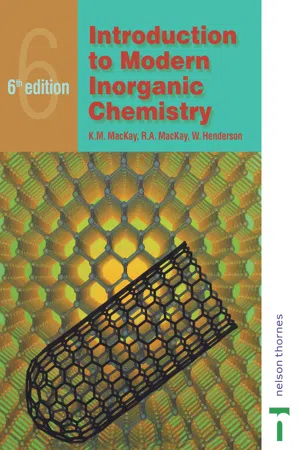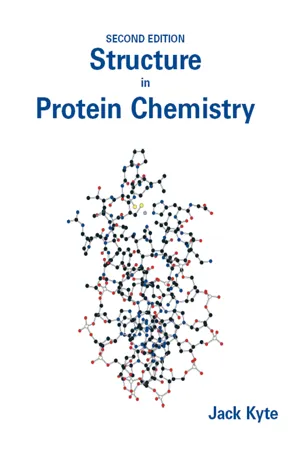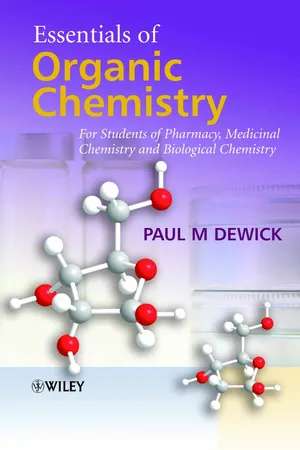Chemistry
Sigma and Pi Bonds
Sigma and pi bonds are types of covalent bonds formed between atoms. A sigma bond is a single covalent bond formed by the head-on overlap of atomic orbitals, while a pi bond is a type of double or triple bond formed by the side-to-side overlap of p orbitals. These bonds play a crucial role in determining the structure and properties of molecules.
Written by Perlego with AI-assistance
Related key terms
Related key terms
1 of 4
Related key terms
1 of 3
5 Key excerpts on "Sigma and Pi Bonds"
- eBook - ePub
- Jeffrey Gaffney, Nancy Marley(Authors)
- 2017(Publication Date)
- Elsevier(Publisher)
These are sigma orbitals and pi orbitals as shown in Fig. 3.10. Molecular orbitals that are symmetrical about the axis of the bond are called sigma molecular orbitals, denoted by the Greek letter “σ.” They lie between the nuclei of two atoms where there is an increase in electron density along the bond axis. This increase in electron density causes the nuclei of the two atoms to be drawn closer together. In sigma antibonding orbitals (σ⁎), there is a low electron density between the nuclei of the two atoms, which destabilizes the bond. Sigma molecular orbitals can be formed from the combination of two s atomic orbitals, as in H 2, or from the combination of two p atomic orbitals that lie along the axis of the bond (p z). Pi orbitals are formed from the combination of two atomic orbitals that lie outside of the bond axis (p x, p y). This results in a side to side overlap of the atomic orbitals. The pi bonding orbital, denoted by the Greek letter “π,” thus has no electron density along the bond axis. Instead, the electron density lies above and below the bond axis. The electron density in the pi antibonding orbital (π⁎) lies entirely outside the bond axis. Fig. 3.10 The shapes of bonding and antibonding molecular orbitals formed from the combinaton of two of the atomic orbitals shown at left. The black dots indicate the location of the nuclei. Single covalent bonds consist of one sigma molecular orbital. Double bonds consist of one sigma molecular orbital and one pi molecular orbital. Triple bonds are made up of one sigma molecular orbital and two pi molecular orbitals. The number of bonds between two atoms is called the bond order. The bond order can be calculated from a molecular orbital diagram as; Bond order = ½ b − a m (4) where “b” is the number of electrons in bonding molecular orbitals and “a” is the number of electrons in antibonding molecular orbitals. If the bond order is zero, no bonds are produced and the molecule is not stable - eBook - ePub
Chemistry for Pharmacy Students
General, Organic and Natural Product Chemistry
- Lutfun Nahar, Professor Satyajit D. Sarker(Authors)
- 2019(Publication Date)
- Wiley(Publisher)
Pi (π) bonds never occur alone without the bonded atoms being joined by a σ bond. Therefore, a double bond consists of a σ bond and a π bond, whereas a triple bond consists of a σ bond and two π bonds. A sigma overlap occurs when there is one bonding interaction that results from the overlap of two s orbitals or an s orbital overlaps a p orbital or two p orbitals overlap head to head. A pi overlap occurs only when two bonding interactions result from the sideways overlap of two parallel p orbitals. The s orbital is spherical in shape and p orbitals are dumbbell shapes. Let us consider the formation of the σ overlap in hydrogen molecule (H 2), from two hydrogen atoms. Each hydrogen atom has one electron, which occupies the 1 s orbital. The overlap of two s orbitals, one from each of two hydrogen atoms, forms a σ bond. The electron density of a σ bond is greatest along the axis of the bond. Since s orbitals are spherical in shape, two hydrogen atoms can approach one another from any direction resulting in a strong σ bond. cssStyle="font-style:italic;" 2.3.4.2.3 Covalent Bond Cleavage Covalent bonds are broken either homolytically or heterolytically. A homolytic cleavage is the breaking of a covalent bond, where each fragment gets one of the shared electrons. Thus, homolytic cleavage produces free radicals (see Section 5.3). In a homolysis reaction, a single‐headed arrow is used to show the movement of a single electron. A heterolytic bond cleavage is the breaking of a covalent bond where one atom gets both of the shared electrons. Typically, heterolytic bond cleavage is most likely to occur in polar bonds, and the electrons will move towards the more electronegative atom. Whereas homolytic bond cleavage produces electrically charged ions, as cation and anion - R.A. Mackay(Author)
- 2017(Publication Date)
- CRC Press(Publisher)
Fig. 4.24 ).Similarly, the triple bond in hydrogen cyanide, H-C=N, is localized between the carbon and nitrogen atoms and formed by the overlap of the pi and py orbitals of the carbon and nitrogen atoms.FIG . 4.23Localized n bonds in a phosphane oxideFIG . 4.24Localized n bonds in a sulfoxideSuch localized π bonds are obviously similar to those in diatomic molecules, but they are relatively uncommon in inorganic chemistry. Most π bonds are delocalized over a number of atoms and are best discussed in terms of many-centred atomic orbitals.For example, in the carbonate ion, CO2 3 – , all the experimental evidence shows that all three oxygen atoms are equivalent, and so a structure with a localized π bond, such as, is incorrect and a description of the ion must be found which keeps the equivalence of the oxygens. This is done by first deriving the shape of the molecule by the methods of Section 3.7 . We then describe the σ bonding. This may be done in terms of hybrid orbitals and two-centre bonds or in terms of delocalized σ orbitals. Since we are going to use delocalized orbitals for the π bonding it seems more logical to do so for the σ bonds also. We shall indeed do this for later examples, (Fig. 4.28 and 4.30), but for this first example we shall used the localized, two-centre model to illustrate what is still the commoner approach. In this, once we have accounted for the electrons and orbitals used (a) in σ bonding and (b) to account for lone pairs, we then have available the remaining orbitals and electrons to form the π- eBook - ePub
- Jack Kyte(Author)
- 2006(Publication Date)
- Garland Science(Publisher)
Any carbon, nitrogen, or oxygen that has contributed a 2 p atomic orbital to a system of π molecular orbitals has only two other 2 p atomic orbitals remaining to hybridize with its lone 2 s atomic orbital, but any carbon, nitrogen, or oxygen that is not involved in a system of π molecular orbitals has three 2 p atomic orbitals to hybridize with its 2 s atomic orbital. It is these hybrids between s atomic orbitals and p atomic orbitals that overlap to form σ bonds. These σ bonds lie along the line of centers between the two respective atoms that they connect, and they are localized. Because they are localized, they are usually stronger covalent bonds than π bonds, and as a result every pair of atoms joined by one or more than one covalent bond must be joined by one σ bond. These σ bonds form the molecular skeleton defining the structure of the molecule, in particular its bond angles. This skeleton is the σ structure of the molecule. Each σ bond is also an occupied molecular orbital, but this realization is not informative in issues of molecular structure. In the particular instance of molecules in biological situations, when an atom has contributed one p orbital to a system of π molecular orbitals, it will almost always be hybridized [ p, sp 2, sp 2, sp 2 ]. At that atom in the σ structure, the molecule will be planar, and the σ covalent bonds and σ lone pairs will radiate within that plane in three directions from the atom at approximately 120° angles. When an atom has not contributed a p orbital to a system of π molecular orbitals, it will almost always be hybridized [ sp 3, sp 3, sp 3, sp 3 ]. At that atom in the σ structure, σ covalent bonds or σ lone pairs will radiate in four directions tetrahedrally, at angles of approximately 109.5 °. Because the σ structure incorporates these bond orders and bond angles, it dictates the details of molecular structure. These details cannot be appreciated until decisions on hybridization can be made correctly - eBook - ePub
Essentials of Organic Chemistry
For Students of Pharmacy, Medicinal Chemistry and Biological Chemistry
- Paul M. Dewick(Author)
- 2013(Publication Date)
- Wiley(Publisher)
Figure 2.7 ). This produces a bonding π molecular orbital with regions of greatest probability of finding electrons above and below the atomic axis. The π bond thus has a nodal plane passing through the bonded atoms. The antibonding π* orbital can be deduced in a similar manner. Double and triple bonds are characterized by π bonding. π bonds possess an enhanced reactivity not associated with σ bonds.Figure 2.7Molecular orbitals: the π bond2.6.2 Hybrid orbitals in carbon
We start this section with a word of caution. Students frequently find hybridization a rather difficult concept to understand and appreciate. However, there is no particular reason why this should be so.Chemistry is an experimental science, and to rationalize our observations we gradually develop and invoke a number of rules and principles. Theories may have to change as scientific data increase, and as old principles cease to explain the facts. All of the foregoing description of atomic and molecular orbitals is a hypothesis for atomic and molecular structure supported by experimental data. So far, the description meets most of our needs and provides a good rationalization of chemical behaviour. However, it falls short in certain ways, and we have to invoke a further modification to explain the facts. Here are three observations based upon sound experimental evidence, which are not accommodated by the above description of bonding:- The hydrocarbon methane (CH4 ) is tetrahedral in shape with bond angles of about 109°, and the four C–H bonds are all equivalent and identical in reactivity.
- Ethylene (ethene, C2 H4 ) is planar, with bond angles of about 120°, and it contains one π bond.
- Acetylene (ethyne, C2 H2
Index pages curate the most relevant extracts from our library of academic textbooks. They’ve been created using an in-house natural language model (NLM), each adding context and meaning to key research topics.
Explore more topic indexes
Explore more topic indexes
1 of 6
Explore more topic indexes
1 of 4




